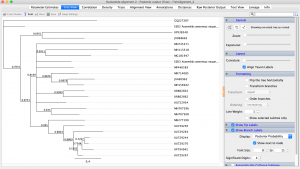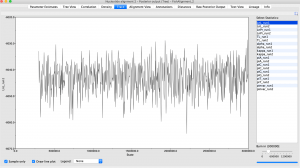This week, we extracted DNA from Erythranthe guttata leaf samples collected in the field (see Lab 3 for collection methods). The following methods are modified from Alexander et al. DNA extraction protocol.
- I labeled three 2.0 milliliter tubes with my sample codes: NPI-1, PRBW 006, and MONO 007.
- I added three sterile, 3.2-mm stainless steel beads to each tube.
- I added a small amount of dried leaf tissue from the field collection vials to each tube, making sure to clean the forceps between tubes to prevent contamination.
- My lab group loaded our samples into a modified reciprocating saw rack and mounted the rack to the saw. We turned on the saw, which shook the samples back d forth on speed 3 for 40 seconds.
- We briefly spun the tubes in a centrifuge for 20 seconds at full speed to pull the plant material down to the bottom of the tube.
- I added 434 microliters of the preheated grind buffer to each tube.
- Then, I incubated the buffered grandame at 65 degrees Celsius for 10 minutes in a hot water bath, mixing the tubes by inverting them every 3 minutes.
- Next, I added 130 microliters of 3M pH 4.7 potassium acetate, inverted the tubes several times, and incubated on ice for 5 minutes.
- I loaded the tubes in a centrifuge and spun at maximum speed (14,000) for 20 minutes.
- In the meantime, I labeled new 1.5mL micro centrifuge tubes with the sample IDs. I transferred the supernatant from the centrifuged samples into the new tubes. I avoided transfer of the precipitate.
- Then, I added 1.5x the sample volume of binding buffer (700 microliters) to each new sample tube.
- I added 650 microliters of these mixture to Epoch spin column tubes. I centrifuged these tubes for 10 min at 14,000rpm. When finished, I disposed of the flow-through in a hazardous waste container.
- I added 650 more microliters of the mixture from step 11 into the Epoch spin column tube, and repeated the spin and disposal of waste.
- To wash the DNA bound to the silica membrane, I added 500 microliters of 70% EtOH to the column and centrifuged at 14,000 rpm for 8 minutes. Then I disposed of the flow-through.
- I repeated the washing step, adding more EtOH, spinning, and discarding the waste.
- Then I ran another centrifuge spin with the tubes for 5 min at 14,000 rpm to dry out any residual ethanol.
- I placed the columns in new, sterile, labeled 1.5-mL micro centrifuge tubes.
- We added 100 microliters of preheated (65 degrees Celsius) pure sterile H2O to each tube. We let them stand for 5 minutes, then centrifuged for 2 min at 14,000 rpm.


